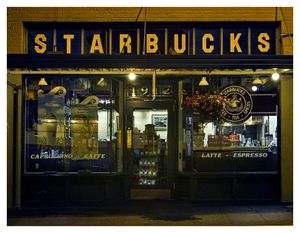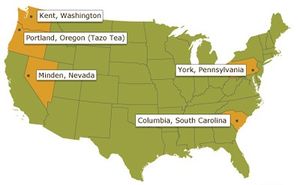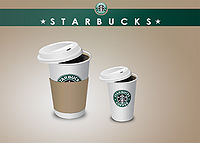Course:HIST104/Starbucks Coffee
| Starbucks Coffee | |
|---|---|
| HIST 104 | |
| Section: | 99C |
| Instructor: | Joy Dixon |
| Josh Horowitz | |
| Email: | |
| Office: | |
| Office Hours: | |
| Class Schedule: | |
| Classroom: | |
| Important Course Pages | |
| Syllabus | |
| Lecture Notes | |
| Assignments | |
| Course Discussion | |
Starbucks History
“We aren't in the coffee business, serving people. We are in the people business, serving coffee.” Starbucks is a well known brand which has become a staple in North American culture and has expanded to countries world wide. Founded in 1971 in Pike Place Market in Seattle, Washington, it was taken over by Howard Schultz in 1982 when he saw the potential of the company; he envisioned a company that did more than sell coffee, but also provided a place where people could connect with one another.[1] Starbucks has become a place where people can go to have the 'coffee experience.'
By 1987 Starbucks had expanded to 17 chains; by 2010 Starbucks had created over 16,000 coffee houses around the world. Starbucks.com claims that their coffee is brewed using ethical sourcing practices. Starbucks serves more than 30 blends as well as several handcrafted beverage including lattes, cappuccinos, and espressos.[2] One of the key characteristics of the Starbucks company and their products is the fact that Starbucks promotes a place of identity, uniqueness, and origin: “where we came from.”[3]
The Beginnings
Starbucks began with three friends that wanted to sell premium coffee beans and equipment. Jerry Baldwin, Zev Siegl and Gordon Bowker brought Alfred Peet’s custom style of coffee bean roasting to Washington from California, where Peet owned Peet’s Coffee and Tea. Peet was the master and “guru” of coffee roasting, and is largely regarded as the person responsible for specialty coffee revolution in the United States.[4] The three friends also bought the green coffee beans they roasted from Peet directly in the first year of operation. The combination of Peet’s mentorship, aggressive expansion, and ingenious marketing led to Starbucks being viewed as the largest coffee roaster in Washington by 1980.[5]

Throughout its long history, the coffee house developed into a meeting place; “a third place” as Starbucks now markets.[1] [6] The reason that coffee houses did not fade into the backdrops of history is because they became a place of comfort, inspiration, and entertainment that people have not been able to find elsewhere, a home away from home. Howard Schultz saw the potential in traditional coffee houses and brought that gift back to America. Starbucks then, under the guidance of Schultz, emphasized on "connection." Connection is core of coffee houses, it allowed ancient coffee houses to persist in times of turmoil, and it is a determining factor in the rise of the international coffee brand. Starbucks does not solely depend on their coffee and foods to create special coffee experiences. They have established the coffee experience through the environment as well.
What goes into a cup of Starbucks Coffee?

Starbucks coffee is not a homogeneous product per say so that there is not a single variety or version, and hence it is offered in a variety of different forms (such as hot or cold) and with a variety of different brews (such as decaf, Americano, etc.). In the first place, the coffee used by Starbucks varies, with coffee originating from many different sources. However, although the origin is varied, Starbucks coffee is ethically sourced and the company strides to purchase Freetrade certified coffee and Organic certified coffee. The first is good for the farmers by providing better working conditions for the workers and clear ways to ensure transparency and humane working conditions in coffee plantations, amongst many benefits, while the second helps reduce the environmental footprint of Coffee plantations.[7] The origin of the coffee itself is in itself very diverse, with Colombian, Kenyan, Sumatran and Guatemalan coffee offered for instance.[8] Inspiration for the coffee is likewise drawn from a variety of sources, with holiday blends available and other blends that incorporate coffees from different regions of the world and hence different flavours. Thus, Starbucks brings products from all corners of the globe to the reach of consumers, whether in Chile and Argentina, or Canada and the United States.
The coffee beans come from different parts of the world and as such possess different qualities, allowing Starbucks coffee to provide a wide range of choice to consumers. Coffee is a truly global industry with plantations in many different countries, in an area roughly bound by the Tropic of Cancer and the Tropic of Capricorn.[9] This provides consumers with a variety of different roasts to choose from. Although Coffee is not native to many of the regions that produce it, coffee farming has adapted well to many distinct regions within the area between the two Tropics. Although coffee had originated from Africa, the two largest producers are in South America, with Brazil and Colombia leading the way in global coffee output. [9] The globally sourced coffee thus makes its way to the cups of consumers across Starbucks locations around the world, providing costumers with a wide range of roasts.
There are other ingredients to a cup of Starbucks. However, these are of secondary importance to both customer and producer since the actual coffee blends are the source of uniqueness in the product offer by Starbucks. The blend and the brew of the coffee are the sources of Starbucks success as a coffee shop, with consumers being able to choose from a wide variety of both of these.
Where do different components of Starbucks Coffee originate from?
The coffee beans that Starbucks coffee uses in its many stores come from various parts of the world, but originally, the Starbucks' story can be dated back to the 1950s when a Dutch immigrant, Alfred Peet, started to import Arabica beans to the United States [10] Nowadays, in order to provide its customers with various blends of coffee, the Starbucks team travels around the world to different coffee plantations to purchase their beans and look for new and exciting flavors [11]. The differences in soil, climate and altitude of different coffee producing regions directly affect the aroma of the coffee beans produced. The company nowadays sends their coffee bean buyers to coffee plantations throughout three main regions between the Tropic of Cancer and Tropic of Capricorn: Latin America, Asia/Pacific and Africa/Arabian Peninsula [11]. This way, not only does Starbucks coffee provide the regular blends that are available daily in store, but they can also offer new special blends from various regions such as Java Indonesia[12] , Antigua Guatemala[13], Kona, Hawaii[14], Nicaragua[15],and Sidamo, Ethiopia[16].

The coffee beans from various regions of the world is not the only component that makes Starbucks coffee unique. Starbucks' roasting processes of beans is another essential component to the aromatic beverage. In the start, Starbucks coffee was originally a simple store in Seattle’s Pike Place Market[18]. At that time, the store had their imported beans dark-roasted and grinded locally in Seattle. The roasting method Starbucks used at that time was a European style that they learnt from Peet[10]. Nowadays, Starbucks coffee is no longer roasting the beans in Seattle alone as they have expanded significantly; the company now owns five main roasting plants in Washington, Oregon, Nevada, Pennsylvania and South Carolina [17] in the United States and also in Amsterdam, Netherlands [18] that process coffee beans from all over the world into numerous blends of different flavours.
Not only have the origin and processing of coffee beans changed over the time, but the product offered by Starbucks coffee has evolved substantially since the beginning. When Starbucks coffee first established in 1971, the local store only featured the selling of whole roasted coffee beans and related coffee products. Fresh brewed coffee was only provided as sample but not as product during that time[10].The concept of coffeehouse was first introduced and tested in 1984, 13 years after the company’s establishment. Nowadays, Starbucks coffee mainly functions as a coffeehouse brand that offers freshly brewed coffee to their customers; they also sell pre-roasted coffee beans, bottled coffee beverages and also instant Starbucks coffee mixes[18].
Last but not least, as mentioned above, FairTrade is also another virtual but important part of Starbuck's process. Before entering the licensed agreement of fair trading, which happens much after the founding of Starbuck coffee store, the company was already involved in various local-helping programs such as involving in local literacy program in 1997 and promoting sustainable coffee-growing practices in 1999. Only later, in 2002, did the company join the licensing agreement with national FairTrade organizations to sell Fairtrade certified coffee in all the stores.[18].
Starbucks coffee undoubtedly represents cultural contact in both the production level and the retail level. The production of a cup of freshly brewed coffee involves growing and harvesting of coffee cherries by local farmers in coffee plants, the extensive testing and investigation of Starbucks scouts, transportation through various national borders, and substantial evolution in the roasting practices of Starbucks [11].
Historical forces behind Starbucks coffee and "a third place"
In the beginning, Ethiopians served coffee at home for guests. Back then, coffee beans were treated in procedures that resemble modern coffee roasting and grinding.[19] The drink eventually spread across the Islamic world through trade and began to make its impact around the world. In that period, wealthy people began to have coffee rooms within their very homes, whereas the less affluent frequented coffee houses and developed the first coffee shops.[20]
However, in 1511 the coffee houses of Mecca were forced to shut down due to political reasons. The Governor of Mecca named Khair-Beg, heard about disgraceful comments about him from these coffee houses and outlawed coffee by the Karan. However, coffee had become so popular and necessary, as part of the islamic culture, that the ban was eventually overturned and the coffee houses given another opportunity.[21]
Over the next century, coffee was disseminated throughout the West, through the expansion of trade and the opening of new trade routes that connected Europe to the Middle East. Therefore, as a result of inter-cultural connections, coffee houses were established in Europe. Throughout the world, the coffee houses became gathering places for good conversation and company. Intellectuals frequented such houses often and eventually began to frequent them for social reasons as they provided a venue for communication. Similarly, artists began to frequent the coffee houses. Coffee houses became instrumental to intellectuals as gathering areas and some even claim that coffee houses facilitated the French Revolution.[22] In London, there were more than 2000 coffee houses by the year 1700, again due to the huge success of coffee throughout the world. In addition to the French Revolution, coffee historians have also argued that the insurance company, the stock exchange, and several newspapers were born in coffee houses.[23]
In 1689, the first American coffee house was established.[24] But, it wasn’t until the late eighteenth century when Americans were discontent with the taxation imposed on tea, that coffee had its opportunity to become the mainstream beverage. Coffee was planted in closer proximity to North America and was therefore cheaper than tea. However, it was in large part the exploitation of labor through the slave trade that made the coffee trade more profitable.[25] The eighteenth century was indeed a turning point in American coffee history and subsequent events furthered the inclusion of coffee in American culture and developed to what we now call "coffee culture".[26]
References:
- ↑ 1.0 1.1 http://www.starbucks.com/about-us/our-heritage
- ↑ http://www.starbucks.com/about-us/company-information
- ↑ http://search.ebscohost.com.ezproxy.library.ubc.ca/login.aspx?direct=true&db=a9h&AN=31999976&site=ehost-live
- ↑ http://www.nytimes.com/2007/09/03/us/03peet.html
- ↑ http://www.voteforus.com/starbuckshistory.html
- ↑ http://www.starbucks.ca/coffeehouse/store-design
- ↑ http://www.starbucks.com/responsibility/sourcing/coffee
- ↑ http://www.starbucks.com/coffee/menu
- ↑ 9.0 9.1 http://www.nationalgeographic.com/coffee/map.html
- ↑ 10.0 10.1 10.2 http://www.mhhe.com/business/management/thompson/11e/case/starbucks.html
- ↑ 11.0 11.1 11.2 http://www.youtube.com/watch?v=bNcx_E1x3D0
- ↑ http://www.starbucks.com/coffee/reserve/blue-java-indonesia
- ↑ http://www.starbucks.com/coffee/reserve/guatemala-antigua-santa-catalina
- ↑ http://www.starbucks.com/coffee/reserve/kona-coffee
- ↑ http://www.starbucks.com/coffee/reserve/nicaragua-diamond
- ↑ http://www.starbucks.com/coffee/reserve/organic-ethiopia-sidamo
- ↑ 17.0 17.1 http://www.starbucks.com/career-center/roasting-plant-positions
- ↑ 18.0 18.1 18.2 18.3 http://assets.starbucks.com/assets/aboutustimelinefinal72811.pdf
- ↑ Mark Pendergrast. Uncommon Grounds: The History of Coffee and How It Transformed Our World,2nd edition. Basic Books, 2010. p.5
- ↑ Pendergrast. p.6
- ↑ Pendergrast. p.6
- ↑ Pendergrast. pp.8-9
- ↑ Pendergrast. p.12
- ↑ Pendergrast. p.14
- ↑ Pendergrast. pp.14-15
- ↑ Pendergrast. pp.
Others works:
- Thurber,Francis Beatty. Coffee: from plantation to cup: A brief history of coffee production and consumption, 15th Edition. American Grocer Publishing Assocication, 1889
- The Story of Coffe. http://www.ico.org/coffee_story.asp International Coffee Organization
